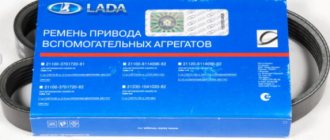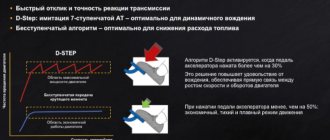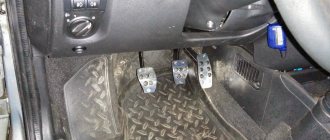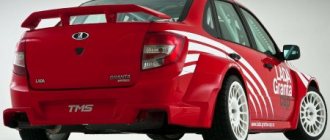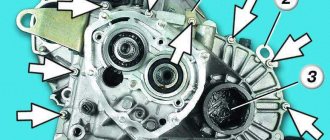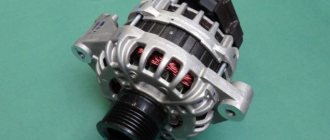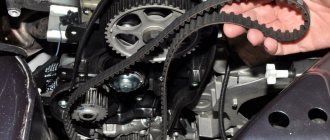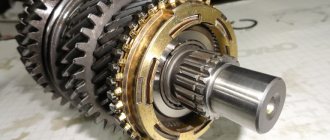All the disadvantages of the Lada Granta liftback
➖ Quality of finishing materials ➖ Extraneous noise in the gearbox ➖ Suspension
pros
➕ Spacious trunk ➕ Warm interior ➕ Economical
The advantages and disadvantages of the 2018-2019 Lada Granta hatchback in a new body were identified based on reviews from real owners. More detailed pros and cons of the Lada Granta liftback with manual, automatic and robot can be found in the stories below:
Owner reviews
About comfort. There is, one might say, no noise at all. After the Hyundai ix35 crossover, I, of course, had a culture shock for some time. Now I’m used to it and I can even say that this is the ideal car for work. First of all, thanks to the incredibly low fuel consumption.
Returning to comfort. Two conflicting opinions: for the first year and a half, my back began to ache when traveling further than 50 km (in the driver’s seat). And my wife in the back seat says that it’s much more comfortable than on the back seat of the ix35!
The robot they put on Grant is wonderful. I mean that it is practically devoid of those shortcomings that the first Opel and Toyota robots had.
The dynamics are just fire! The car is light and playful. Of course, not everyone can be left at traffic lights, but... True, after 60 km/h the dynamics begin to fall.
Alexander, review of Lada Granta Liftback 1.6 (106 hp) with AMT robot 2015
Video review
Liftback, robotic gearbox, 106 horsepower engine, electric power steering, front electric windows, 60/40 rear seat, air conditioning, etc. In general, the package is “Normal”.
The first sensations from the robot are dull (I need to get used to it, this is my first such experience), but there are no vibrations! There is no noise by definition, the wheels can be heard frankly well. The visibility in the mirrors is similar to that of televisions. It feels a little wobbly when cornering, but tolerable.
Salon? Provides enormous tuning opportunities, the main thing is not to overdo it! I'll install music, floor mats, armrest, Shumka... All this is ahead. I would like to put a spoiler, maybe the thresholds.
The owner drives a Lada Granta liftback 1.6 (106 hp) with a robot, produced in 2015.
Impression? I bought it in April, to date the mileage is 21,220 km, so far I have only changed the clearance light bulb (I don’t count the maintenance). There are advantages compared to the Priora (I don’t take into account the earlier cars I owned), but there are also disadvantages. Advantages:
— The gearbox clearly switches gears, but howls (infection).
— Running lights (on Priora low beam lamps, consumables).
— The air conditioner works better (personal opinion).
— The suspension is softer (passes speed bumps without braking).
— Fuel consumption is less.
Among the shortcomings, so far I can only note the howl of the gearbox.
Alexey, review of Lada Granta liftback 1.6 (106 hp) manual 2017
So, I’ll walk through the car, at the same time comparing Grant with Kalina.
Engine. The 16-valve engine installed here is noticeably quieter than the old eight-valve engine that was on my Kalina. It doesn't rattle like a tractor, it runs smoothly. Because of the run-in, I don’t press on the gas, I accelerate smoothly, but the potential is felt. If you have the money, I think you should buy a car with just such an engine. I didn’t regret it, although I initially wanted an eight-valve one.
Fuel consumption was scary at the beginning; the car consumed 12-14 liters in mixed mode. After about 500 kilometers, consumption dropped, and now it is 7.5 liters per hundred in the combined cycle, outside the city 5-5.5 liters. All this takes into account the fact that I don’t put pressure on the gas, I calmly accelerate and brake. My consumption on Kalina was higher - 9-9.5 liters per hundred in mixed mode.
Robotic gearbox on the Lada Priora: advantages and disadvantages, reviews from owners
The robotic gearbox on the Lada Priora is a kind of hybrid, an intermediate option between a manual transmission and an automatic transmission. Accordingly, advantages and disadvantages arise from its design. The unit implements the “foolproof” concept, which completely eliminates accidental gear shifting, which can lead to sudden overload of the engine. Switching to manual mode allows the gear to be reduced by one speed, which protects the transmission and power unit from overload.
If you intend to purchase a Vesta, Grant or Priora robot car, reviews from the owners will help you better understand the operation and ease of use of this type of transmission.
The main advantages of an automated transmission:
- Low fuel consumption. A robotic car spends almost the same amount as a manual one.
- Small amount of oil. Up to 4 liters of liquid must be poured into such a box. This is two times less than with a similar automatic transmission or CVT.
- High clutch life. Since the switching process is controlled by electronics, and not by the driver, the risk of burning the clutch is close to zero (unless you intentionally press the gas and brake pedals at the same time).
- Availability of semi-automatic mode. At any time, the driver can switch to manual mode and independently choose the moment when to shift to a higher or lower gear.
Drivers also note high switching speeds even in automatic mode. And all thanks to the use of a multi-disc clutch. When the car is moving in first gear, the second disc is already engaged with the next one.
Clutch types
There are several types of clutches for AMT gearboxes:
In the first case, electric motors are used. This type of drive has a slower response speed. Gear shifting is three to four times slower than a similar one with a hydraulic drive. Switching time ranges from 0.3 to 0.5 seconds. But still faster than an automatic transmission.
AMT gearbox - what is it?
AMT - Automated Manual Transmission - automated manual transmission. Car enthusiasts call such a box robotic or, simply, a robot.
This is a reliable manual transmission, known since the very beginning of the automotive industry, but with automatic shifting. Simply put, if you are asked, “AMT gearbox, what is it?”, boldly answer: “It is a mixture of manual and automatic.”
That is, the gearbox is mechanical, but the computer depresses the clutch and changes gears based on its calculations.
It takes data from various car systems, analyzes speed, ABS readings, etc., and then, using force transmitting devices - actuators or also called servos, switches gears.
In AMT boxes, actuators are either electric or hydraulic.
- The electric robot with a single clutch is the most common, it is cheaper, but its reaction time is longer.
Such boxes are installed on budget cars. And it is they who cause dissatisfaction among motorists and a skeptical attitude towards AMT.
The fact is that when accelerating a car, you may feel “freezes” when changing gears and even a decrease in speed at the most inopportune moment (for example, when changing lanes or overtaking).
There may be no traction between the engine and the wheels for up to two seconds, which impairs the car’s handling and irritates those who like to drive fast and harshly.
However, this is a good option for those who like a smooth and measured movement.
- A hydraulic robot (also called electrohydraulic) is more expensive and is installed on premium-segment cars and sports models.
The hydraulic one uses a cylinder that is pushed by solenoid valves.
A special liquid is poured into such a box, which allows you to reduce the thought time to 0.05 seconds.
- Since 2003, the Audi and Valkswagen concerns began installing dual-clutch robots on their production cars.
The technology itself was invented back in the 80s of the last century. The box has two shafts at once: one for even gears, the second for odd ones.
The next gear on the adjacent shaft is engaged in advance, but it is open until the required moment. When the electronics decide it is time to switch, one shaft is simultaneously disconnected and the other is connected.
This gear shift is called preselective. Thanks to him, the car gets a very smooth ride, the driver does not notice the switching.
For example, on a Volkswagen Golf it occurs in just 8 milliseconds. If you see the abbreviation DCT (Dual Clatch Transmission), then it is a dual-clutch robot.
Also, in common parlance, it can be designated by the abbreviation DSG, after the name of the box of the Volkswagen concern, but be manufactured by another company (by analogy, the words copier, diaper, etc. appeared in the Russian language)
AMT gearbox
When it comes to the pros and cons of AMT, it’s worth immediately remembering what is an AMT gearbox?
This is a combination of the reliability and low cost of a manual transmission with the convenience of an automatic transmission.
From this we can understand that it combines the pros and cons of both types of transmissions.
pros:
- There is no need to depress the clutch and move the gearshift lever, the computer will do it. Particularly relevant in urban traffic jams.
- Cheaper than an automatic transmission, but there are still two pedals. This gives the convenience of an automatic at a price approaching that of a manual.
- It is more reliable and easier to repair than an automatic transmission, because the gearbox is, in fact, mechanical.
- On many models, you can change gears manually if necessary.
- Fuel consumption is lower than that of cars with automatic transmission and manual transmission. In an automatic transmission, the operating principle itself implies higher consumption, and in a manual transmission, the driver plays a role with his driving style and untimely switching.
- The AMT gearbox weighs less than an automatic transmission. It is suitable for small cars.
- The service life of a dual-clutch robot is longer than that of a manual transmission.
- Less oil required in the box.
Minuses:
- When accelerating, the time between gear changes may take about two seconds. This applies to AMTs with an electric actuator and one clutch. This “freezing” can be unpleasant when overtaking on the highway, and also impairs the car’s handling at the time of shifting.
- AMT with a hydraulic actuator puts a greater load on the engine, which significantly increases fuel consumption.
- Unlike an automatic transmission, the robot cannot adapt to the driver’s driving style, so you will have to adapt to the transmission.
- Preselective gearboxes are more expensive than their counterparts and are difficult to repair if they break down.
- During a long climb, the clutch may overheat, then it opens and you have to switch to manual gear shifting.
Tips and tricks for riding an AMT
To get used to the robot box and increase its service life, you can follow little tricks to make driving enjoyable and not cause negative emotions.
- One of the most unpleasant things that can happen on the road with an AMT is clutch overheating. To prevent this from happening, in a traffic jam, when stopping for longer than 10 seconds, you can put the gearbox in the “neutral” position, and during a long climb, force a manual downshift. If the box is overheated, an icon will appear on the panel. You need to stop, turn off the car and wait until the AMT cools down.
- To avoid jerking when changing gears during acceleration, you need to press and then slightly release the gas pedal at the moment when you feel the gears changing soon. After switching, you can continue to gradually pick up speed.
- At each maintenance, calibrate the box, this will increase its service life.
The question “AMT gearbox - what is it?” For many car enthusiasts it remains open or causes skepticism.
Some have heard negative reviews from friends and acquaintances and do not want to buy, others have tried to drive older models of a robotic gearbox.
But with the development of technology, when AMT is gradually replacing both mechanics and automatic transmissions, a robotic gearbox can become the best and most economical option for a car.
The manufacturer recommends changing the transmission fluid at least once every 60 thousand kilometers. The cost of new oil for AMT is 4 thousand rubles. You also need to buy a new filter for 500 rubles. An oil change is carried out at a specialized service and costs about 2,200 rubles.
While driving, the driver can set the gear shift lever to automatic or semi-automatic mode. In the first case, the transmission operates by relying on sensor readings and impulses from the electronic control unit. As for the semi-automatic mode, “Tiptronic” is activated here, which can be found on Mercedes cars with their automatic transmission. There is a plus/minus switch on the gear lever.
Technical shortcomings - how else can you criticize Robot 2.0?
A small database of reviews about the second generation of the robotic box has already been collected. The first clutches have already fallen off, so be careful with this creeping mode. But that's not the worst thing. You just need to get used to the behavior of the box and understand how it should be operated without putting unnecessary stress on the main parts. Otherwise, there are still a lot of shortcomings that will apparently be eliminated in robot 3.0. I wonder if AvtoVAZ specifically left these shortcomings so that there would be something to work on further?
There are several general disadvantages of the new gearbox:
- the kick between first and second gears remains, before it was a failure, but now it’s a kick, but the discomfort from this change has not become less, there is a desire to drop the gas pedal;
- the reverse gear is engaged inadequately, the car is already rolling, and at this time the driver feels a noticeable blow, as if on an old Japanese automatic machine that requires major repairs;
- the creep mode in first gear is very aggressive, and this not only constantly affects the clutch, but also wears out your pads, since you have to constantly brake;
- the design of the unit may not be the best, since the assembly is Russian, so precise mechanisms and parts of foreign design may not take root in a domestic device;
- it is not entirely clear whether the device will withstand the loads placed on it; it seems that Vesta is too heavy and large for this gearbox, and this feeling is only getting stronger.
Maybe such a robot will behave perfectly on Grants. It is quite possible that there we will not pay attention to his quirks at all. But Vesta is the flagship of the corporation, and the buyer has more complaints about its quality of operation. And so far the machine does not behave very adequately with the robot. It is much easier to buy simple mechanics and drive a car without problems and troubles. And the service life of a manual transmission will be much higher than that of a robotic one. There can be no debate on this issue.
What's on the road: reviews from some owners of the 2016 Lada Vesta robot?
Experienced motorists liked the ability to move the gearshift handle from the forward position to Reverse when slipping at a speed of less than 3 km/h. At the same time, switching time is reduced to 0.7-0.8 seconds. However, drivers do not recommend abusing this - the clutch overheating indicator may go off, and you will have to wait until the clutch cools down.
Manufacturers of the Lada Vesta robot and reviews from owners in 2016 claim that shifts have become smoother than those of Kalina or Priora, but longer. The box was reconfigured and the original control unit was installed on it. Loss of traction for 1.7 seconds in city traffic threatens, at a minimum, with the horns of hurrying drivers. Meanwhile, it is possible to select manual mode and work ahead.
Problems with the Robot
The AMT (robot) mechanism itself is quite reliable: The box is painfully familiar to all of us, and the actuator inspires confidence. The actuator has a service life of 10 years, officially it is not repairable, but now they do everything, and repairing such an actuator is not a problem, the main thing is to lubricate it well. But there are the following “jambs” with the robot, but mainly related to the first, early models:
Long switching . As mentioned above, this is not a problem, it is a feature. Use manual mode.
Valeo clutch . As it turned out, Valeo does not match the Vesta in terms of vehicle weight, which is why current models receive a Sax clutch. Valeo quickly wore out, there was a difficult start, slippage and clutch smell were felt. The first Vesta models received the Valeo clutch.
Lada cars with AMT reviews from owners
Most often, owners of cars with such a manual transmission complain about delays or jerks when switching. They are especially noticeable when driving in city traffic or when starting up a hill. Sometimes this robot generally behaves inappropriately, sometimes it will drop several gears for no reason, sometimes, on the contrary, it drives for a long time and strainedly at high engine speeds, without even intending to shift.
The second inconvenience is the lack of a rolling mode, as on a hydromechanical automatic transmission, which is so convenient in traffic jams. When a car slowly crawls in automatic mode, after releasing the brake pedal, everyone expects that they will move on, because the gearbox is in gear. But no, you need to press the accelerator. Update: version 21827 received a rolling mode.
Let's sum it up
Modern generation cars from AvtoVAZ have become much better than the previous ones, but buyers want even more progress and pleasant updates from the Russian concern. While buyers complain about high prices, Lada is actively saving on everything it can save on, and is also experiencing constant financial difficulties. It's amazing how you can sell so many cars and still struggle with money. The VAZ plant has always succeeded in this and continues old traditions with pleasure. But irony aside, Robot 2.0 turned out to be one of the concern’s best technical developments.
At least the company is trying to do something with the unit and improve it. Today, this technology provides certain additional capabilities to the driver, drives well, and copes well with difficult Russian travel conditions. Also, the robotic box can be slightly modified for installation on elevated versions of the Cross. Most likely, the robot will get a slightly smoother ride in first gear in crawling mode as an update, which will improve the clutch life and reduce discomfort for the driver in the process of getting used to the car. Did you like the characteristics of the new robot from AvtoVAZ?
Factory AMT gearbox on Priora: price and article number
The new gearbox in VAZ was developed on the basis of an old frozen project. In 2009, the development of a manual transmission for golf-class cars was closed, but good performance led engineers to the idea that the VAZ-2116 gearbox, a new generation of manual transmission, could become a prototype for an automatic transmission.
A robotic automatic transmission with electric actuators from ZF is now used in front-wheel drive Ladas. The automatic transmission has code 2181 for Kalina and Granta, and the Priora has an automatic transmission with code 2182. A Lada Priora car with AMT at the dealer and on the secondary market costs about 20 thousand rubles more than a Priora with a “mechanics”. It works in four positions: R, N, A and manual gear shift (“+” is responsible for upshifting, “-” is responsible for downshifting).
About the design
What does an AMT gearbox consist of? This transmission includes several components:
- Drive and clutch discs.
- Gear shift lever.
- Electronic control system.
Any robot uses a double friction clutch. On conventional mechanics, one disk is used. This design allows for faster gear shifting on AMT. The Lada Vesta, on which robotic gearboxes began to be installed, is much faster than its manual counterpart. And this despite the fact that the AMT does not have a clutch pedal as such. But not only the Volkswagen-Audi concern and AvtoVAZ use such a box.
Editorial Lada Vesta: searching for a common language with the AMT box
What is a robotic box
I have always been sure that robotization of a conventional manual transmission is far from a dead end. In the end, few people complain about the poor performance of the manual transmission itself, about the slowness and jerkiness of shifts, about “dullness” and other shortcomings for which automated transmissions are usually criticized.
Automation can switch gears faster and more accurately than a person - this is a simple task in which a living organism has no chance against electronics. It simply cannot achieve the precision, speed and coordination that a simple microcontroller provides. The shortcomings of even the simplest “robots” are the shortcomings of people who tried to make them cheap, and at the same time, even the algorithms for operating service electronics were cheap.
If you do it better, then the result will be at least no worse than that of a person. With only one exception - the automatic transmission does not know when the gas will be pressed and when it will be released, which means it cannot switch in advance, and is forced to act “after the fact”. Often - at the most inopportune moment, which increases the requirements for switching time several times.
"Never again"
The skeptical attitude of most drivers towards VAZ’s AMT “robots” has many reasons. First of all, this is the experience of those who have operated similar transmissions produced by Opel, Ford, Toyota and Honda. Until recently, Opel Zafira, Ford Fusion, Toyota Corolla and Honda Civic were among the bestsellers on our market. In addition to these models, the companies had other carriers of similar units, but slightly less popular.
Numerous reviews clearly stated that it is not recommended to buy a car with such a transmission. The Japanese especially distinguished themselves - their “robots” really exhausted the soul, and the most neutral opinion of the owners was “never again.” European models were better. I've driven a Zafira, a Corsa and a Fusion and can say that with good maintenance, regular grip point adjustments and a very relaxed driving style, the cars were easy to use.
But we couldn’t forget for a second that this was a “robot.” Algorithms taken from classic automatic transmissions and multiplied by design imperfections sometimes made passengers twitch like clowns on strings. The advantages in the form of efficiency usually faded when calculating the cost of the next repair - the clutch life turned out to be frankly insufficient, just like that of clutch drives during city use.
In general, such boxes deservedly received the fame of problematic transmissions. Against the backdrop of all this “disgrace,” the release of VAZ cars with an AMT transmission was perceived with doubly skepticism. It is clear that such “automation” is due to a lack of funds for more advanced designs. But the reviews about the driving characteristics turned out to be surprisingly positive, but I don’t see any Prior owners with AMT. Everything changed when the new Lada Vesta came out, and it again has an AMT “robot” as an automatic transmission; there are no other options yet. What has changed in the design and why does Vesta’s “robot” objectively work better than the others?
A few words about the design
Nothing has changed fundamentally: it is a conventional mechanical transmission, to which an automatic control system has been installed. Moreover, the gearbox is original VAZ, with its very short first gear and inevitable howling under thrust and under throttle release. In contrast, by the way, from cars with “mechanics”, which now use a Renault-made gearbox.
Why was the AMT for Vesta made on the basis of the VAZ gearbox? The designers say that the load on the box when automating the switching process is even lower than usual, and the design features and lower price make it more competitive. The control system is supplied by ZF, which has extensive experience in mechanical automation. True, for the most part this experience was not very successful, because Opels and Fords also had their production systems. But the latest generation with more recent switching algorithms is offered for VAZ. And it seems that the whole point is in the settings and logic of operation, because the car, as they say, “drove.”
The selector lever does not have a Parking position - only reverse, neutral, auto mode (analogous to Drive) and manual switching. Moreover, when shifting manually, you cannot go into neutral or engage reverse, only forward gears.
Why is the absence of “creeping mode” a good thing?
To start, you need to move the gearbox selector to position “A” (auto mode) and lightly press the gas, otherwise the car will not move. Unusual? But it is very useful in terms of reliability!
The AMT gearbox does not try to imitate hydraulic automatic transmissions and avoids the problematic mode that so often overheats the clutch on DSG robots in traffic jams. The essence of the problem is well understood by those who have driven a manual car for quite a long time. Without traction, the clutch has to be closed for a very long time and carefully, it manages to get very hot, or even start to “burn”. When adding traction, the start is much faster, and there are no jerks or vibrations.
Moreover, the clutches close most quickly when you carefully operate the gas; when starting “to the floor,” there is again a clear pause in operation, but even in this case there are no jerks. The most unpleasant outcome is, again, when copying the “automatic” algorithms of machines with classic gas turbine engines . If you sharply press the gas at the start and then release it, there will be a pause at the start, a jerk, and an unpleasant vibration of the engine.
Review of VAZ Granta 1.6 (2015)
I wish you all good health! Reading reviews is of course pleasant and useful, now you also need to make your contribution, so don’t judge harshly, especially for mistakes (I was in a hurry, and I want to write more + no, the beech is stiff and the buttons are small).
Lada Granta (luxury equipment)
ICE: 1.6; 16th grade; 106 l/s, gearbox: 5st. robotic.
Equipment: ABS; 2PB; 4ESP; Climate; Heated front seats; Rain sensor; Two rear parking sensors; Fogs; Wheels R15; Radio with touch control; Standard alarm.
1. Introduction.
Over 11 years of driving experience, I personally owned: the first was my grandfather’s Moskvich 412 (whatever this car couldn’t stand from me), then the VAZ 2105 1.3 85 onwards. on gas (after Moskvich, a comfortable and stable car), VAZ 2106 2006. (drove for about 2 years), then an almost new 2105 (injection 5-speed, also drove for about 2 years), Toyota Platz 2001. (I got the car in excellent condition, drove it for 3 years, didn’t know any problems, but I wanted more and lost it), Nissan Cefiro 1998. 2.5 210 hp Neo-Di engine which does not run on gasoline below 95, the car is cool but already old and it eats gasoline normally + expensive insurance, taxes (drove for 2 months and sold it), Honda Civic 2000. 1.5 (8 valve automatic - I was shocked myself) right-handed sedan made for the Emirates, no ABS, no airbags, terrible stove... but there is a leather interior and climate control (the car was received in poor technical condition. I thought I’d do it little by little, but it didn’t work out due to financial difficulties, I thought it was about to break down BUT! the car was almost unchanged in technical parts, traveled 3 - and the year!!! I bow to her, the car is really very reliable and durable, although it is designed for good roads and active driving, so the chassis is quite harsh). All cars are worthy of special attention, but we are not talking about them now. And now……. TA-DAM! New Lada Granta))
You can find a bunch of reviews about the latest foreign cars that I owned, maybe I’ll post them sometime, but Granta with a robot is a fairly recent example on our market, so writing a review about it is more relevant. The mileage is only 2000 km. so it's too early to judge the quality. I will add information as time passes and mileage increases))).
I will say right away that I am not a fan of the domestic automobile industry due to its backwardness from modern technologies and the very poor quality of units and spare parts (there is something to compare with). I don’t understand why our people are always trying to reinvent the wheel. It’s a shame that the state forces people to drive products assembled in the Russian Federation, it seems to me that if not for the wild customs duties on foreign cars, AVTOVAZ would have folded a long time ago, BUT it’s a pity to leave people (factory workers) without work, so we are all taking the rap. We don’t make cars, but carts for the backward and poor, which I am. I apologize for going off topic.
I decided to refresh the car, sell the Honda and add a loan. Money is tight in the family, so I couldn’t take any risks. We got used ones......if you don’t have good friends or relatives who sell “candy”, then the search for a good used car can take a long time + it’s difficult to find out the real mileage + after each driver you need to redo something for yourself, etc. Tired of it! I wanted something new. Even worse, during this crisis, car prices soared by at least 50-70 thousand. Before this I wanted a new Solaris or Rio. And because I’m a fan of automatic transmissions, but now they cost under 700 rubles in good configuration. + interest on the loan + CASCO about 70 tr. per year...... in short SPACE. And it’s a bummer they didn’t give me the loan in cash. I sold the Honda (for 130 rubles), they won’t give me a loan, and without a car my life has completely stopped. I didn’t sleep for two nights, thinking and thinking. Before this, I was constantly on websites, reading reviews, looking at used ears. I have test driven: Granta, Solaris, Rio, Mazda 3, Sportage, Polo Sedan. As a result, I went to a VAZ car dealership to apply for a loan; representatives of 4 different banks were sitting in the salon (VTB, Cetelem, Bystro Bank, Rusfinance). At that time, I quit my job for like 3 days. Setemel refused, Rusfinance too, VTB refused..... here I am sitting opposite the last girl and frankly saying that I am unemployed, but I promise to pay on time and OH A MIRACLE in 15 minutes. approval comes. Well, what could I do? I agreed to 3 years at 8% per annum + insurance. As a result, the overpayment is even less than in other banks without insurance (not advertising). Why Granta? Because I needed CHEAP and ANGRY + so that everything would be for a comfortable stay in the car (air conditioning, heating, music, ESP, ground clearance, not mechanics). Well, Granta is being released on new “rails”, unlike the obsolete Priora.
I wanted to buy an automatic, but they were all dismantled, and further production with an automatic transmission is a thing of the past due to the rise in price of this unit (bought for $ in Japan). Now we got smart and, together with the Germans, made a mechanism for squeezing the clutch and shifting gears for our 5-speed manual transmissions. There was only one car in the full configuration and with a robot in the cabin, and I took it)) (I’ll post a photo later) Of course, there was a test drive first. I’ll say right away that two years ago, as soon as the Granta came out, my friend and I took it for a ride (also a test drive) out of curiosity: the car’s gearbox hummed a little, it pulled well, it didn’t hold the road level, we had to constantly steer. And this time the car drove smoothly (I read that the steering was modernized + it also depends on the tires), the engine was relatively quiet in the cabin, the engine was almost inaudible, nothing creaked and the gearbox was also humming. Half a day of paperwork and I am the “happy” owner of a brand new Lada Granta.
2) First impressions
Let's immediately decide that my impressions and assessments are aimed at the domestic ECONOMY class car (i.e., by default, a cheap hard worker) and I will compare it not with the Japanese, Germans, French and Koreans, but more with the previous domestically produced cars to replace which Grant did it. I don’t even want to hear about the Chinese, I don’t trust them (maybe for now).
After inspecting the car for any damage, I got behind the wheel. To start the internal combustion engine, you must press the brake pedal (for the first two minutes I sat there, wondering why the car wouldn’t start, I already wanted to go back for help, but then I saw that the pedal pressure light was on). I start it up and go. The seats, unlike the luxury older brothers Kalina and Priora, are not height adjustable, but it’s comfortable for me to sit. While driving, the engine is practically inaudible and on the highway at a speed of 90-110, the car is really comfortable and quiet, only aerodynamic noise from the mirrors and the rustle of rubber can be heard. The tires, although they say Pirelli, are full, just like the wheels (two days later the wheel hit a sharp hole in the asphalt, it couldn’t withstand such abuse and, like a boom, it actually exploded, 1100 RUR they applied a tourniquet, now there is a small hernia on the wheel and the disk is scratched) . Pleasant little things like a rain sensor, parking sensors, radio, climate control are very pleasing. When the air conditioner is turned on, the car practically does not lose power, even with 4 crew members, the engine pulls, and this is taking into account that it has not even been run-in)) True, the air conditioner is noisy, something inside is rumbling, buzzing...... but it works. I haven’t figured out the standard alarm system yet; it has some strange operating algorithms (several modes and all of them are inconvenient). In general, first impressions are good; honestly, I was preparing for the worst.
3) Detailed description
Appearance. I'll definitely post a photo later. It depends on everyone)) It’s clear that naked from the factory on the stamps does not look like ice, but it can be tinted. I'm even starting to like my Grantochka. The R15 wheels were already installed from the factory, I just tinted and tightened the hood, front bumper and mirrors with armored film. I advise you to immediately change the wiper blades and plastic seals on the windows (hard and scratchy). And also oil in the internal combustion engine and gearbox and spark plugs (they are branded Russian).
Salon. Everything is simple and accessible. True, when checking the license plates at the traffic police, I couldn’t find the hood opening lever, the three of us searched until the inspector took pity (I won’t say where they found it). The Luxury has height-adjustable headlights. The standard music doesn't play badly to begin with. Pleasant little things: there is somewhere to put your left foot, a light bulb and an outlet in the trunk. The dashboard is very informative, before your eyes all the necessary parameters are in electronic form, except for the tachometer and speedometer (temperature of the internal combustion engine, amount of fuel in the tank, shows what gear you are driving in + variable readings of the on-board computer: outside temperature, average fuel consumption, instantaneous fuel consumption, how long is left before refueling, how many hours the car has been running, it seems there is also a cruise control function). The trunk is large and spacious, the rear backrests fold down into an almost flat floor (it’s a blast in a lift back). There is not much room for the legs of the rear passengers, when landing at the bottom there is a narrow opening, they will constantly dirty either the backrests or the upholstery......in short, the comfort for the rear passengers is minimal, except for the air ducts to the feet. The interior has one big drawback: the cheapest, easily soiled and scratchy (very scratchy) plastic. And the fabric also gets dirty, I immediately put on the covers made of inflated leatherette (or beautiful eco-leather)
Hodovka. As I wrote above, earlier (2 years ago) I took Grant for a test drive. The car did not keep straight and was scouring the road. Now there is no such thing. The car calmly drives straight and almost does not react to the track (they say that they have modernized the steering mechanism, strengthened something in it + tires also have an effect on handling). Once I drove into a deep rut in the asphalt and the car really didn’t want to get out... but that’s nitpicking. The chassis is very elastic, it’s a real thrill on the highway up to 120 km/h, in the city it doesn’t notice small bumps at all, but when it comes to big ones it bounces back like a ball......jump-jump and that’s it. When cornering, due to the narrow base and high ground clearance, it rolls slightly, but tolerable. Again, if you lower it a little, wider the wheels and increase the rear camber...then it will be better)) The brakes are good, although it can be difficult to dose evenly, it seems to be normal, but the rear passengers are a few centimeters from the seat backs. The steering wheel is a bit empty, but you get used to it in a couple of days. While driving, I feel a little like I’m driving a SUV (tall, slightly wobbly), it’s actually a pleasant feeling, the road and its condition don’t scare you at all. Narrow, maneuverable, tall. True, the protection of the internal combustion engine hangs a little low, so don’t forget about it when you conquer the urban or suburban jungle.
ICE. Slightly modernized 1.6 16 valve from Priora 106 hp. Because I’m not really testing it out yet, but I can say with confidence that there’s potential already. Grant has plenty of it. Electronic throttle smoothes out sudden movements of the leg, so acceleration and release of the throttle are much smoother. The engine pulls really well, enough to easily overtake long trucks on the highway without the slightest doubt (you just switch to a lower gear in advance and forward). Moreover, the engine just pulls, you don’t even need to rev it up, the robot sometimes turns on fifth already at 60 km/h and it drives calmly. In 4th gear at 2 thousand. rpm the car calmly rides up a slight rise with the air conditioner and passengers. It eats 95 benz, you can fill it with 92, but with it the cravings get worse. In terms of fuel consumption (during running-in): the onboard shows an average consumption of 8.2. On the highway they say there are 6 liters. An interesting fact: when I’m driving on a flat surface, keeping the speed in 5th gear at 70 km/h, the instantaneous consumption shows 4-4.5 liters))) Honestly, I’m not lying, I can take it on video.
Robotic box. So I got to the most delicious and intriguing).
I am a rabid fan of automatic machines because... I choose comfort. I never saw the point of constantly pulling the handle just to drive from traffic light to traffic light. If you want drive, then the car should have about 200 horses, then yes. And pushing around in the city with a stirrer only strains your kneecap and one hand must constantly be distracted from the steering wheel. In short, it’s a matter of taste, I personally am for comfort. Why am I saying this, but to the fact that I wanted Grant on an automatic rifle (a good Japanese automatic rifle), but they were all sold out and will no longer be produced due to economic disadvantage (due to the increased dollar). I absolutely did not want to study mechanics. Now VAZs are equipped with robotic gearboxes or later AMT. What is a robot? I immediately ask you not to confuse them with automatic transmissions and CVTs. The robot is the same mechanical 5-speed VAZ transmission, it simply switches gears for you and squeezes the clutch (two mechanisms (one shifts, the other squeezes). These mechanisms, thank God, are not ours, but German, from some ZF company (I don’t remember exactly), comrades from Porsche participated in their setup, the gearbox was tested in the mountains, in the cold, and on the highway, etc. (I read about it on the net).
It was a long time ago when I had a ride with a friend in a Corolla with a robot, but honestly I didn’t like it, I could just hear all these shifts in throttle, squeezing the clutch and its smooth release, as if the gear was doing everything for you. But in Grant, you won’t believe it, it’s almost inaudible. There is an auto mode, when the transmission selects the speed itself, you can turn it on in neutral right at speed when you are driving towards a traffic light (it is not recommended to do this on automatic machines), when you stand at a traffic light for more than 7 seconds, you must turn on neutral because at this time the car is standing with the clutch depressed and, like any mechanic, rolls back. There is also a manual switching mode, downwards if necessary (deceleration) it lowers itself, and up only with feed. After an automatic transmission, of course, it’s not the same, you need to constantly turn on neutral, the smoothness of the ride is already closer to a manual one, it shifts smoothly like a polite driver, so significant dips are felt (especially from first to second, when the whole flow goes forward). But after three days you get used to it and you’re not so mad anymore, you calm down and just go. The car can move off smoothly; when you put it in neutral, it almost instantly shifts into gear without delay.
What advantages do I see: 1) The electronics do not allow you to shift what and when you want, so you cannot engage reverse or unnecessary gear while driving 2) Smooth shifting is more of a protection against fools and, accordingly, will extend the life of the clutch and gearbox 3) Fuel economy t .To. the electronics clearly selects the desired gear depending on the situation. Sometimes even 5 at 60 km.h. And you don’t have to do anything extra with the gas pedal; the revolutions themselves drop and rise during switching. I would not recommend taking a car with a robot for those who are constantly stuck in traffic jams, and in cities where there is more or less traffic or the mileage from work to the dacha will generally work. I would also not recommend it to those who do not know how to drive a manual transmission. you can forget that you are on the mechanics and roll back)).
Conclusion. To be honest, I’m happy with the car and I’m even starting to love it more every day. For our cars this is progress (I emphasize for OURS). Cheap and multifunctional. Now half of the cars are assembled in Russia, almost all of them have cheap plastic in the interior, a short engine life, and high maintenance costs. And the famous old Japanese and Germans are already really very old. So I decided to get a new car within my means. I think that the car is suitable for its purpose, of course it’s a little expensive, but now everything is expensive. I hope my review will be useful)). On the technical side, it’s too early to say, I’ll write back as soon as there’s something new.
General information about the AMT robot
- The mechanical part is based on a five-speed modification of the VAZ model 2180 gearbox. Moreover, this gearbox is equipped with gear pairs with different output ratios for different Lada models. For example, the Vesta box has this output indicator of 3.9, when, as on Grants and Kalinas, it is 3.7.
- You cannot take an actuator (clutch pressing mechanism) and robot electronics and put it on a regular box of the same VAZ 2180 model so that the result is a robot. Although the reverse procedure of replacing a robot with a mechanical one can be carried out with overcoming some obstacles.
- It is believed that the actuator cannot be repaired or maintained, but this is not for our craftsmen. Cases of its failure, judging by the reviews, are very rare. Usually, they happened at the beginning of operation, while still under warranty. There were no cases of refusal to replace.
- The recommendation to change the oil in the AMT at a mileage of 120 thousand does not stand up to the criticism of mechanics; they recommend doing this at 75 thousand mileage.
- The adaptability or adaptability of the transmission to changing operating conditions of the engine and its load, the position of the gearbox engaged mode sensors (ECP), as well as the gas and brake pedals is ensured by reading the sensor information and analyzing this information. And based on the algorithms embedded in the robot’s program, a certain order of its actions is formed. In this case, the driver’s actions in various situations are taken into account, which are stored in the robot’s long-term memory. If we say all this in a simple and understandable language for everyone, then the AMT transmission adapts to the characteristics of the driving style of a particular driver and road conditions. Moreover, for this she usually needs a couple of tens of kilometers of driving in the city.
- The AMT robot is sensitive to engine load and quickly responds to the activation of maximum torque. At the same time, each subsequent gear can be engaged only when the engine speed drops below 2.5 thousand, and each subsequent one when the range from 4 to 4.5 thousand revolutions is reached. In addition, the degree of load perceived by the engine is taken into account. For example, on a slope, the AMT robot will switch to a lower gear if the load on the engine decreases, but will leave it in the most economical operating mode.
- AMT has its own peculiarities of operation in accordance with the established transmission modes. For example, in “M” mode, the gearbox switches faster compared to “A” mode.
Lada Vesta and manual transmission: five reasons to buy for and four against
A certain part of motorists continue to ignore the achievements of transmission cybernetics and choose cars with a manual transmission. If we analyze their arguments, we can formulate five main reasons based on which it is worth considering this option:
- Affordable price - the basic model costs 509,000 rubles, for the robot you need to add 25,000 rubles. If you take a car with a manual transmission, then for the money you can get a higher level of equipment. A new AMT robot unit from a dealer costs 56,200 rubles, plus about 10,000 more for installation, so if something happens, the amount for repairs is quite impressive, which cannot be said about a manual gearbox.
- Full configurations – for models with manual transmission there is no discrimination in terms of configurations. If you want a “full stuffing” of a car, that’s not a question, and it’s not necessary to take a robot because of the additional options.
- Pleasant dynamics - according to documents, a car with a manual transmission accelerates to 100 km/h 1 second earlier than its automatic counterpart. In practice, this is significant time, which does not allow you to sweat when overtaking.
- Reliability - according to reviews and tests of the Lada Vesta, the mechanics did not give any particular cause for alarm, especially since in case of repairs the costs will be significantly lower.
- Potential liquidity - after a certain time, selling a car with a manual transmission on the secondary market will be much easier.
Vesta "robot" - AMT
AMT for Lada Vesta was initially created only for the Lada Priora car. The fact is that the design of this model did not allow the use of full-fledged automatic transmissions, and the plans were to produce this car for a long time. To develop the “robot,” we took an ordinary mechanical box as a base and added a computer and drives from the German company ZF. The unit turned out to be so successful that it subsequently appeared on Grants and Kalinas, completely replacing automatic transmissions.
The AMT box has also reached the Lada Vesta. Successful operating experience of this unit made it possible to use it on more modern cars without any modifications. Among the technical features of the “robot”, it is worth noting the low weight - only 5 kg heavier than the “mechanics”, low cost - 20,000 rubles, versus 40,000 rubles for the JATCO “automatic”, as well as the simplicity of the design - a well-known gearbox and several controls.
Disadvantages of the "robot":
- When parking uphill, the car rolls back, so you need to fix the position with the gas pedal or hand brake.
Advantages of the “robot”:
- Protection against incorrect gear engagement;
- Two switching options are possible, fully automatic and manual;
- Possibility of sharp acceleration as on mechanics;
- One or two gear reset mode;
- Average fuel consumption is 6.5 liters per 100 km in urban modes and 5.1 liters per 100 km on the highway;
- The required oil volume is 2-3 liters, for automatic transmissions and CVTs from 7 to 10 liters;
- You can start driving immediately after starting the engine, including in severe frosts;
- Automatic adjustment of the transmission mode to the driving style of a particular driver;
- There are no vibrations in the gearshift lever;
- Ability to tow trailers or other vehicles;
- Quick gear changes, no jerking.
Features of the robotic gearbox:
The clutch closes very smoothly, even if you press the gas sharply; If necessary, you can manually reset one or two gears for quick acceleration; There is protection against engaging reverse gear when moving forward; There is a howl in certain gears, but it is several times less than in the “mechanics” from AVTOVAZ; The service life of the AMT is 10 years.
What is the difference between AMT and automatic transmission?
How does the robot on the Vesta work and how does it differ from a car with an automatic transmission? In terms of structure, it is designed exactly the same as a manual transmission. A robotic one has little in common with an automatic transmission. If in a conventional automatic transmission the torque is transmitted from the engine to the wheels by a torque converter, then in a robotic gearbox the torque is transmitted through gears. The robot was made on the basis of a VAZ mechanical transmission. The AMT consists of the mechanical box itself, the clutch and the electronic unit that controls it.
When developing the new box, engineers from the Tolyatti plant used the experience of foreign manufacturers. And the clutch included in the AMT package is made in France. The part is protected by a wear compensation function that prevents premature failure. There have not yet been any cases of warranty claim registered.
Many people are perplexed: why can’t an automatic transmission be developed on a Russian basis, because so far no domestic car has such an improvement. The answer is simple: the development of automatic transmissions is possible already on the existing base, which does not yet exist in Russia. And production based on foreign developments will significantly increase the final cost of the car. For comparison, using an automatic machine will cost approximately twice as much as a robot.
Test drive Lada Granta Cross on a “robot”: tests on the M5 highway and village dirt
Sometimes it is difficult to take on the role of a lawyer because you know in advance that the case will be lost. But it’s either passion, or duty and a matter of honor - and you take it on. It's boring at first: all the scripts are known in advance and differ only in details, like good remakes. But as you dive in, something clicks inside, and the “bartender” you’ve known since birth slips you a strange cocktail of sympathy, empathy and hope... And with this Lada Granta Cross it couldn’t be otherwise.
What does it look like
Everyone has already been able to get an idea of the appearance of Granta Cross. This is the same Kalina Cross, which, after restyling in the summer of 2018, had to unite with the Grants family, forming a powerful clan with the best sales results that have been maintained for many months. If you want a quick summary, the Lada Granta Cross looks great.
Features of operation
In accordance with the reviews, a list of custom features of the AMT transmission has been compiled:
- Unlike an automatic transmission, AMT does not have such a mode as “parking” or “P”. Therefore, reviews recommend leaving the AMT in gear when parked, turning off the engine in mode “A” or “R”. And with the engine not running, move the lever to “N” mode, but even in this mode the gear will be engaged. When the ignition is turned on, the speed will automatically turn off. Therefore, you need to remember this feature of the AMT, and to prevent the car from rolling, in this case the car is fixed with the brake pedal. Moreover, the car will not start without pressing the brake pedal. Which some car enthusiasts point out as a disadvantage, and others as an advantage that increases the safety of starting the engine when the speed is accidentally turned on, for example, as with a manual transmission;
- Unlike simple mechanics and an automatic transmission, AMT will not move the car at idle speed, that is, driving at idle speed is impossible. To start moving smoothly, you need to add engine speed by pressing the gas. What is indicated as a disadvantage in reviews from residents of megacities, who often find themselves stuck in traffic jams. Therefore, for those who periodically encounter traffic jams, during short stops it is recommended to switch the lever to the “N” mode, because after a minute of parking with the brake pedal not pressed, the switch will disconnect the clutch by pressing the release lever, which can subsequently negatively affect the release bearing . However, some reviews provide examples of the opposite opinion, that this has absolutely no effect on the condition of the release bearing;
- There are many opinions in the reviews about braking using AMT. When braking the engine by resetting its speed, the AMT reacts quite sensitively in higher gears by switching to lower ones, but many recommend doing this in combination with the brake pedal depressed. Regarding smooth braking with the help of brakes, AMT “helps” to brake by switching lower gears. But during heavy braking, the AMT completely disengages the clutch. But in some reviews there are stories about some “sagging” of the brake pedal in these cases.
- after sharp braking, the clutch remains open until the engine speed is increased by the gas pedal;
- When you apply emergency braking using the brake pedal, the Brake Assist System (BAS) is activated and the clutch is instantly released.
Features of the future “behavior” of the robot
At the beginning of 2022, VAZ conducted surveys of users of cars with an AMT robot, probably noticing that many complaints were coming from car owners living in megacities, who are under the threat of regularly getting stuck in traffic jams, where the gearbox shows not entirely favorable “behavior.” And all this is due to the lack of the so-called “creeping mode”.
If we consider the conditions of being stuck in traffic jams, there are only two types of traffic jams:
- The first type is a standing traffic jam, where traffic occurs in the mode: drive 5-10 meters and stop. In this mode, judging by the reviews, the gearbox robot behaves quite well: the driver pressed the gas pedal - it moved smoothly and began to move, released the gas pedal - it stopped.
- The second type of traffic jam is when the flow of traffic moves at walking speed, where the notorious “creeping mode” is required. In this case, it is difficult for the driver to select the engine speed not in the first gear of the gearbox in order to move synchronously with the flow of cars in a traffic jam, since when adding gas, the gearbox takes a pause while the car is still rolling, and then begins sharp acceleration, while the driver releases the gas pedal and clutch turns off, etc. If you look from the side, the car moves jerkily.
According to yet unconfirmed information, it is precisely this problem of the AMT’s lack of a “creeping mode” that the VAZ developers plan to solve.
"Priora" or "Kalina": classification problems
The word “problem” will generally accompany us throughout the text, and it begins already when determining what is in front of us.
Formally, Kalina is a European B-class, Priora is closer to a C-class. In fact, the difference in dimensions is nominal:
- top-end Kalina station wagon - 4.11 m in length;
- Priora with the same body type - 4.21 m.
At the same time, it is absolutely unclear where the extra decimeter of space went.
In terms of the amount of space in the cabin, it is also unclear which class is which: low seating, minimal gap between the rows of seats - in both cars only short and hardy people can sit in the back for a long time. That is, Mongolian steppe riders.
And it’s even funnier that in both Kalina and Priora, the body type has almost no effect on anything. It’s usually the same: a sedan has a spacious, but most inconvenient trunk, a station wagon is the opposite: it has the maximum displacement and ease of use.
What about LADA? The trunk of a station wagon is not the most spacious, but the most spacious is that of the Granta co-platform liftback (after restyling, this became one family, which makes it even funnier).
The Priora has no difference at all in terms of practicality between body types: both the liftback and the station wagon have 360 liters each behind the rear sofa.
In short, the difference is purely aesthetic. There is no point in looking for a “Kalina station wagon” or a “Priora station wagon” in the hope of seeing space and capacity there.
Also read: Focus on Priora or priority on Accent? Comparing two budget bestsellers

